
  a  mek Lipowiec wznosi się na wysokim skalnym grzbiecie Garbu Tenczyńskiego wysuniętym na zachód od Wyżyny Krakowskiej. Pierwsze umocnienia powstały tu prawdopodobnie na długo przed zamkiem. Gród został następnie przebudowany na drewniany zameczek z inicjatywy Konrada Mazowieckiego. Poważniejszego znaczenia obronnego nabrał zamek po zdobyciu władzy przez Bolesława Wstydliwego, który w 1243 roku polecił biskupowi Prandocie wznieść tu strażnicę w celu ochrony granicy państwa.
Zamek pozostawał dobrem biskupim a w 1295 roku stał się własnością biskupa Jana Muskaty. Za jego panowania znacznie rozbudowano pierwotne założenie. Wówczas wzniesiono pierwsze elementy murowane, między innymi wieżę. Wieża oprócz roli obronnej spełniała też funkcję więzienia dla skazanych na śmierć głodową, których opuszczano na dno głębokiego lochu. Biskup był stronnikiem księcia czeskiego Wacława II, który rościł pretensje do korony polskiej, korona jednak została w posiadaniu Władysława Łokietka, a Muskata musiał się schronić w lipowieckim zamku.
W 1443 roku zamek przestał pełnić rolę rezydencyjną dla biskupów krakowskich. Zbigniew Oleśnicki po wykupieniu Księstwa Siewierskiego przeniósł siedzibę biskupów na zamek w Siewierzu. W Lipowcu powstało więzienie dla duchownych, nadal jednak przebywał tu stale jeden z biskupów, księża oraz załoga wojskowa.
Kolejnej
|
|
Widok z lotu ptaka, fot. ZeroJeden, V 2020 |
|
rozbudowy dokonano w XV wieku, wówczas całość nabrała obecnego kształtu - mały dziedziniec otoczony zabudowaniami mieszkalnymi i położone niżej podzamcze otoczone murem obwodowym. Wieżę nadbudowano o trzy kondygnacje, i w tej postaci zachowała się do dziś w niezmienionym stanie. W dwóch górnych jej kondygnacjach umieszczono przystosowane do broni palnej otwory strzelnicze, z których można było panować nad dojazdem do wjazdu na zamek. Wjazd ten umieszczony był ponad 10 metrów nad poziomem dziedzińca przedzamcza. Kolejne prace modernizacyjne nie naruszyły już w większym stopniu zamku piętnastowiecznego.
Zamek do końca XVIII wieku spełniał rolę więzienia. I to bardzo dobrego więzienia, ponieważ zanotowano tylko jeden przypadek udanej ucieczki. Franciszek Stankar, autor projektu przeprowadzenia reformacji w Polsce został za swe dzieło osadzony w Lipowcu. Około 1550 roku zbiegł z celi, w czym, według legendy, pomogła mu zakochana córka dozorcy więziennego. Po dostarczonych przez nią sznurach opuścił się na zewnątrz.
W 1655 roku zamek zajęli Szwedzi, którzy przeznaczyli
|
|
Zamek Lipowiec, fot. ZeroJeden, V 2000 |
|
go na mieszkanie gubernatora Krakowa, generała Paula Wirtza. Po dwóch latach wycofują c się Szwedzi spalili zabudowania. Odbudowy podją ł się w roku 1732 biskup Konstanty Szaniawski, w 1754 roku ukończył ją biskup Andrzej Załuski. Zamek nie mający już znaczenia militarnego znów zaczął pełnić rolę więzienia, tym razem jednak już nie tak rygorystycznego. Dom poprawy i rekolekcji organizował specjalne seminarium dla więzionych tu duchownych.
W 1789 roku zamek w Babicach został zajęty przez wojska austriackie, co zakończyło długą historię istniejącego tu więzienia. Przez kolejne 60 lat zamek był zamieszkały nawet mimo pożaru z 1800 roku, który uszkodził dość znacznie zabudowania. Całkowicie wtedy spłonęły dachy oraz stropy pomieszczeń na najwyższej kondygnacji.
Zamek pozostał zamieszkały do połowy XIX wieku. W czasie powstania styczniowego w 1863 roku chronił się tu oddział generała Mariana Langiewicza.
Obecnie po pracach konserwatorskich z lat 1961-1968 Lipowiec jako trwała ruina udostępniony jest dla zwiedzających. | 


 a
a

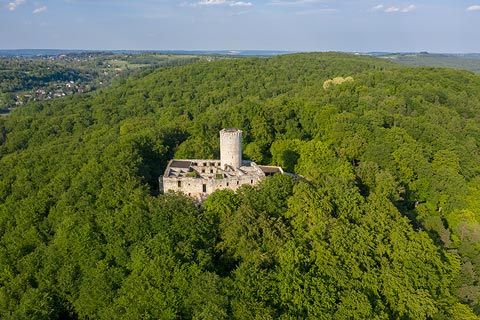
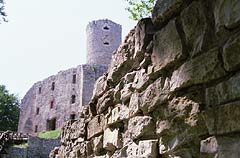




















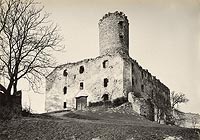







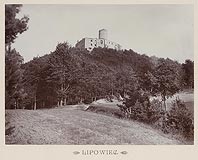
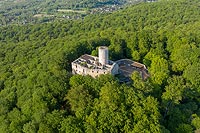


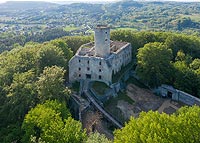
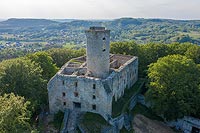

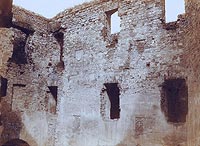


![Zamek Lipowiec w Babicach - Plan zamku zaczerpnięty z 'Leksykonu zamków polskich' <!--[<a href='135' title='Zamek Lipowiec w Babicach - 135' alt='Zamek Lipowiec w Babicach - 135' target=_blank>źródło</a>]--> [<a href=/bibl_ksiazka.php?idksiazki=262&wielkosc_okna=d onclick='ksiazka(262);return false;'>źródło</a>] Zamek Lipowiec w Babicach - Plan zamku zaczerpnięty z 'Leksykonu zamków polskich' <!--[<a href='135' title='Zamek Lipowiec w Babicach - 135' alt='Zamek Lipowiec w Babicach - 135' target=_blank>źródło</a>]--> [<a href=/bibl_ksiazka.php?idksiazki=262&wielkosc_okna=d onclick='ksiazka(262);return false;'>źródło</a>]](https://www.zamki.pl/minig/p_babice2.jpg)


![Zamek Lipowiec w Babicach - Rekonstrukcja zamku XVI-wiecznego według Jana Salma, 'Leksykon zamków w Polsce' [<a href=/bibl_ksiazka.php?idksiazki=262&wielkosc_okna=d onclick='ksiazka(262);return false;'>źródło</a>] Zamek Lipowiec w Babicach - Rekonstrukcja zamku XVI-wiecznego według Jana Salma, 'Leksykon zamków w Polsce' [<a href=/bibl_ksiazka.php?idksiazki=262&wielkosc_okna=d onclick='ksiazka(262);return false;'>źródło</a>]](https://www.zamki.pl/minig/r_babice3.jpg)
![Zamek Lipowiec w Babicach - Rekonstrukcja zespołu przedbramia z XV-XVI wieku według A.Swaryczewskiego [<a href=/bibl_ksiazka.php?idksiazki=307&wielkosc_okna=d onclick='ksiazka(307);return false;'>źródło</a>] Zamek Lipowiec w Babicach - Rekonstrukcja zespołu przedbramia z XV-XVI wieku według A.Swaryczewskiego [<a href=/bibl_ksiazka.php?idksiazki=307&wielkosc_okna=d onclick='ksiazka(307);return false;'>źródło</a>]](https://www.zamki.pl/minig/r_babice4.jpg)

